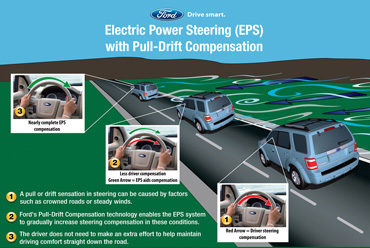
DEARBORN, MI – Ford Motor Co. says its electric-power steering technology will serve as an enabler for future high-tech offerings.
EPS replaces the hydraulic pump and power-steering reservoir found on traditional steering systems with an electric motor mounted on the steering column and electronic-control module that includes “smart” software coupled with a torque sensor, says Ali Jammoul, Ford’s chief engineer for chassis engineering and steering systems.
“EPS provides just the right level of power assist, giving the customer excellent steering feel and crisp steering response,” Jammoul tells Ward’s at a recent event here.
Ford considers EPS a “green” technology, as it improves fuel economy 3%-5% vs. a traditional steering system, while reducing emissions up to 3.5%.
It also reduces a vehicle’s cost of ownership, Jammoul says, noting there is less maintenance involved, while the lack of power steering fluid means leaks are a thing of the past.
Ford says the software-based technology can be adapted to fit the driving characteristics of a particular vehicle, whether it is a luxury sedan or compact cross/utility vehicle.
“You can change the software to tune in different steering curves,” Jammoul says.
![Ford’s pull-drift technology assists in keeping vehicle in straight line.
<link rel="stylesheet" href="http://subscribers.wardsauto.com/galleries/files/lightbox.css" type="text/css" media="screen" />
<script src="http://subscribers.wardsauto.com/galleries/files/prototype.js" type="text/javascript"></script>
<script src="http://subscribers.wardsauto.com/galleries/files/scriptaculous.js?load=effects" type="text/javascript"></script>
<script src="http://subscribers.wardsauto.com/galleries/files/lightbox.js" type="text/javascript"></script>
<p><a href="http://subscribers.wardsauto.com/galleries/2009/ford-eps-pull-drift-compensation.jpg" rel="lightbox[plants]">View Larger Image</a></p>](http://subscribers.wardsauto.com/images/2009/03/ford-eps-pull-drift-compensation.jpg)
Ford’s plans call for 90% of its vehicles, including light trucks, to have EPS by 2012. The system, developed in conjunction with TRW Automotive Inc. and Delphi Corp., first debuted on the ’08 Ford Escape and Mercury Mariner CUVs.
To date, EPS has served as an enabler for two technologies recently introduced on Ford vehicles, pull-drift technology and the patented Active Park Assist system.
Although the pull-drift system debuted on the ’08 Escape and Mariner, Ford has not revealed details about it until now.
The technology utilizes the EPS system’s torque-monitoring capabilities to measure wheel torque applied by the driver to maintain the vehicle’s path and is able to compensate for a variety of road and environmental conditions.
“If you’re on the expressway and the road is crowned to the left or right, you may need to make a slight steering compensation for that crowning,” says Brian Kosztowny, a Ford product development engineer in vehicle dynamics.
“With (pull-drift) compensation, the EPS system gradually will ‘dial in’ torque for easier steering in these conditions, without the driver feeling it or needing to make an extra effort. The electric motor does more, so you don’t have to.”
Ford engineers were careful to make the technology subtle, so that inherent steering issues are not masked.
When a road condition is detected that requires the driver to apply extra torque to the steering wheel, it takes the system about 10-15 seconds to “learn” how to assist in correcting the trajectory of the vehicle and automatically resets itself if the driver turns the wheel 45 degrees or more. However, the system does not work at speeds less than 25 mph (40 km/h).
“It’s all speed based,” Kosztowny says. “In subdivision-type driving, it won’t activate or on streets that are curvy.”
Ford says it will add pull-drift compensation to a number of future vehicles, including the Edge CUV, Fusion midsize sedan and Taurus flagship sedan.
Active Park Assist, which is set to debut this summer as an option on a number of ’10 model-year Ford vehicles, also is enabled by EPS.
The system utilizes two ultrasonic sensors on each side of the front bumper to guide a vehicle into a parking spot, a design Ford says is a “major leap forward in speed and ease of use” compared with camera-based systems offered by competitors.
Whereas most of those systems are on luxury vehicles, Ford intends to offer Active Park Assist across its vehicle range as an option expected to cost under $1,000.
Darrel Recker, Ford’s EPS supervisor, says cameras, unlike ultrasonic sensors, can’t determine if a spot is large enough for a vehicle. “The ultrasonic sensors give you accurate parking measurements ahead of time to get you into your spot more efficiently, and it’s more cost effective.”
Additionally, other systems require drivers to navigate through a number of touch-screen display menus to operate them, whereas Ford’s technology requires the simple touch of a button, Recker says.



